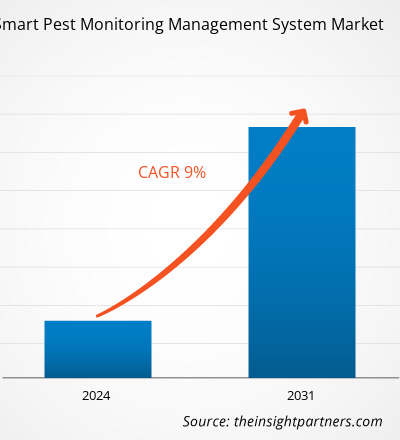智能害虫监测管理系统市场规模预计将从 2023 年的 7.0692 亿美元增至 2031 年的 14.0399 亿美元。预计 2023-2031 年期间市场复合年增长率将达到 9.0%。农业领域采用先进技术的增多以及政府出台的多项智能害虫监测管理系统实施法规可能是市场的主要驱动力和趋势。
智能害虫监测管理系统市场分析
全球范围内,智能害虫监测管理系统市场正在经历显著增长。这种增长归因于农业领域采用先进技术的增加以及政府出台实施智能害虫监测管理系统的多项法规等因素。此外,城市化率和中产阶级人口的增加推动了住宅应用中的害虫控制需求,预计先进技术和应用的不断采用将在未来几年为市场带来诸多机遇。
智能害虫监测管理系统市场概况
提出一种能自动检测害虫侵袭情况,通知农户感染情况,并将获得的实时值与数据库进行比对,识别感染的叶片,并通过GSM模块向农户发出警报的系统。随着智慧农业的推行,昆虫监测系统逐渐应用于农业、林业、园林绿化、海关、专业标准化科技示范园区等诸多领域。监测、预警、预报和预测田间害虫情况变化信息,协助管理者及时制定具体的防治措施。
定制此报告以满足您的需求
您可以免费定制任何报告,包括本报告的部分内容、国家级分析、Excel 数据包,以及为初创企业和大学提供优惠和折扣
-
获取此报告的关键市场趋势。这个免费样品将包括数据分析,从市场趋势到估计和预测。
智能害虫监测管理系统市场驱动因素和机遇
农业先进技术崛起 市场青睐
农业技术领域先进技术的兴起确实推动了市场的发展。由于采用了高级分析和物联网 (IoT),精准农业等技术进步正在获得关注。高级分析利用多种方法和工具来获取和分析有关土壤和产量状况的信息。精准农业实践可能会出现显着增长,因为这些实践使农民能够提高生产力、调节田间波动并降低生产价格。这提高了农业产量,从而增加了智能害虫监测市场的需求。因此,农业技术领域先进技术的兴起正在推动市场的发展。
采用综合虫害管理。
综合害虫管理 (IPM) 是一种有价值且环保的害虫管理方法,它依赖于多种常识性做法的组合。IPM 计划利用有关害虫生命周期及其与环境关系的最新综合统计数据。这些信息与可用的害虫控制方法相结合,以最经济的方式管理害虫危害,并将对人、财产和环境的危害降至最低。此外,各种公司都提供 IPM。例如,LEAF 为农民提供综合害虫管理指南。
智能害虫监测管理系统市场报告细分分析
有助于得出智能害虫监测管理系统市场分析的关键部分是组件和最终用户。
- 根据组件,智能害虫监测管理系统市场分为硬件、软件和服务。预计硬件部分将在预测期内占据相当大的市场份额。
- 根据最终用户,智能害虫监测管理系统市场分为商业、住宅、农业和工业。商业领域预计在预测期内将占据相当大的市场份额。
智能害虫监测管理系统市场份额按地区分析
智能害虫监测管理系统市场报告的地理范围主要分为五个区域:北美、亚太、欧洲、中东和非洲、南美和中美。
北美在智能害虫监测管理系统市场占据主导地位。北美地区各行业的高科技采用趋势推动了智能害虫监测管理系统市场的增长。数字工具的采用率提高和政府机构在技术方面的高投入等因素。农业部门采用先进技术的增加以及政府为实施智能害虫监测管理系统而出台的多项法规预计将推动北美智能害虫监测管理系统市场的增长。此外,美国和加拿大等发达经济体高度重视研发,这迫使北美参与者将技术先进的解决方案引入市场。此外,美国有许多智能害虫监测管理系统市场参与者,他们越来越专注于开发创新解决方案。所有这些因素都促进了该地区智能害虫监测管理系统市场的增长。
智能害虫监测管理系统市场区域洞察
Insight Partners 的分析师已详尽解释了预测期内影响智能害虫监测管理系统市场的区域趋势和因素。本节还讨论了北美、欧洲、亚太地区、中东和非洲以及南美和中美洲的智能害虫监测管理系统市场细分和地理位置。

- 获取智能害虫监测管理系统市场的区域特定数据
智能害虫监测管理系统市场报告范围
| 报告属性 | 细节 |
|---|---|
| 2023 年的市场规模 | 7.0692亿美元 |
| 2031 年市场规模 | 14.0399亿美元 |
| 全球复合年增长率(2023 - 2031) | 9.0% |
| 史料 | 2021-2022 |
| 预测期 | 2024-2031 |
| 涵盖的领域 |
按组件
|
| 覆盖地区和国家 |
北美
|
| 市场领导者和主要公司简介 |
|
智能害虫监测管理系统市场参与者密度:了解其对业务动态的影响
智能害虫监测管理系统市场正在快速增长,这得益于终端用户需求的不断增长,这些需求源于消费者偏好的不断变化、技术进步以及对产品优势的认识不断提高等因素。随着需求的增加,企业正在扩大其产品范围,进行创新以满足消费者的需求,并利用新兴趋势,从而进一步推动市场增长。
市场参与者密度是指在特定市场或行业内运营的企业或公司的分布情况。它表明在给定市场空间中,相对于其规模或总市场价值,有多少竞争对手(市场参与者)存在。
在智能害虫监控管理系统市场运营的主要公司有:
- 拉达尔
- 安提西梅克斯
- 贝尔实验室公司
- 拜耳公司
- 科迪华
- EFOS 门
免责声明:上面列出的公司没有按照任何特定顺序排列。

- 了解智能害虫监测管理系统市场主要参与者概况
智能害虫监测管理系统市场新闻和最新发展
智能害虫监测管理系统市场通过收集一手和二手研究后的定性和定量数据进行评估,其中包括重要的公司出版物、协会数据和数据库。智能害虫监测管理系统市场的一些发展如下:
- FarmSense 推出了一款名为 Smart Trap 的智能害虫监测系统,可帮助农民改善昆虫监测和作物管理。Smart Trap 利用 ML 算法和预测分析来自动化实时昆虫分类过程。(来源:FarmSense 公司网站/时事通讯,2021 年 12 月)
- 先正达在英国推出了用于智能啮齿动物监测的创新型 SecureChoice 远程检测系统。该系统将在米尔顿凯恩斯的 2023 年 PestTech 展会上现场展示(2023 年 11 月 8 日)。(来源:先正达公司网站,2023 年 11 月)
智能害虫监测管理系统市场报告范围和交付成果
“智能害虫监测管理系统市场规模和预测(2021-2031 年)”报告对以下领域进行了详细的市场分析:
- 智能害虫监测管理系统市场规模及全球、区域和国家层面所有关键细分市场的预测
- 智能害虫监测管理系统市场趋势以及市场动态,如驱动因素、限制因素和关键机遇
- 详细的 PEST/波特五力分析和 SWOT 分析
- 智能害虫监测管理系统市场分析,涵盖主要市场趋势、全球和区域框架、主要参与者、法规和最新市场发展
- 行业格局和竞争分析,涵盖市场集中度、热图分析、知名参与者以及智能害虫监测管理系统市场的最新发展
- 详细的公司简介
- 历史分析(2 年)、基准年、预测(7 年)及复合年增长率
- PEST和SWOT分析
- 市场规模、价值/数量 - 全球、区域、国家
- 行业和竞争格局
- Excel 数据集
近期报告
相关报告
客户评价
购买理由
- 明智的决策
- 了解市场动态
- 竞争分析
- 客户洞察
- 市场预测
- 风险规避
- 战略规划
- 投资论证
- 识别新兴市场
- 优化营销策略
- 提升运营效率
- 顺应监管趋势























 获取免费样品 - 智能害虫监测管理系统市场
获取免费样品 - 智能害虫监测管理系统市场